The Littoral Combat Ship did not have a smooth birth. Initially conceived as a sort of coastal corvette, it was adopted by Donald Rumsfeld in his attempt to transform how the US military did business, and soon morphed into a quite large and very fast ship that was supposed to carry modular systems to allow it to fulfill a variety of missions in dangerous coastal waters. Cost overruns drew Congressional ire, but the program survived, and 35 ships are either in service or under contract.
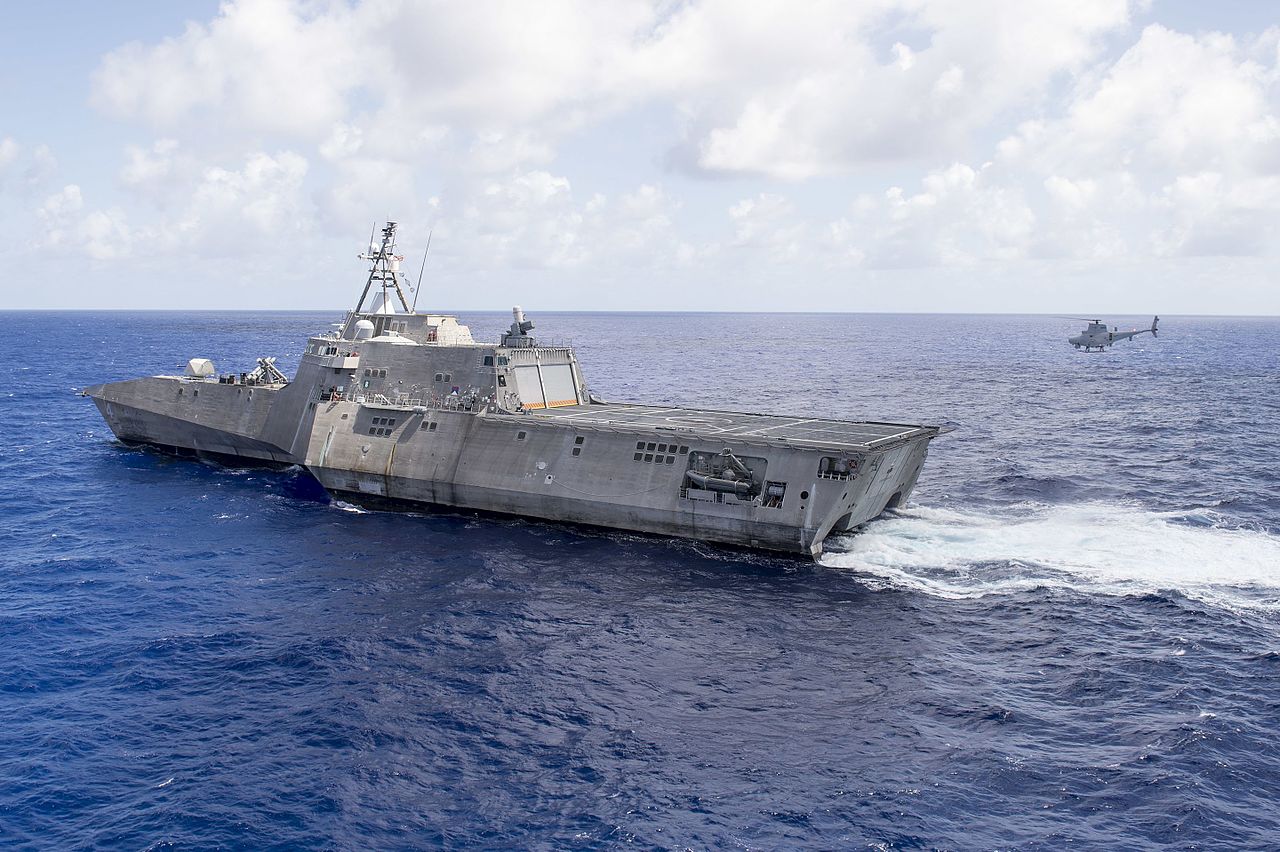
An unmanned MQ-8B Fire Scout comes in to land aboard Coronado (Independence class)
But what sort of ships are they? Two different variants have been procured, the LCS-1/Freedom class, built by Lockheed Martin and Marinette Marine in Marinette, Wisconsin, and the LCS-2/Independence class built by Austal USA at their yard in Mobile, Alabama.1 Despite being built to the same specifications, they are radically different designs. The Lockheed ship is a semi-planing monohull made of steel, while Austal's is a striking aluminum trimaran, both forms driven by the requirement for a speed of around 45 kts, which isn't really practical with a conventional hull.2
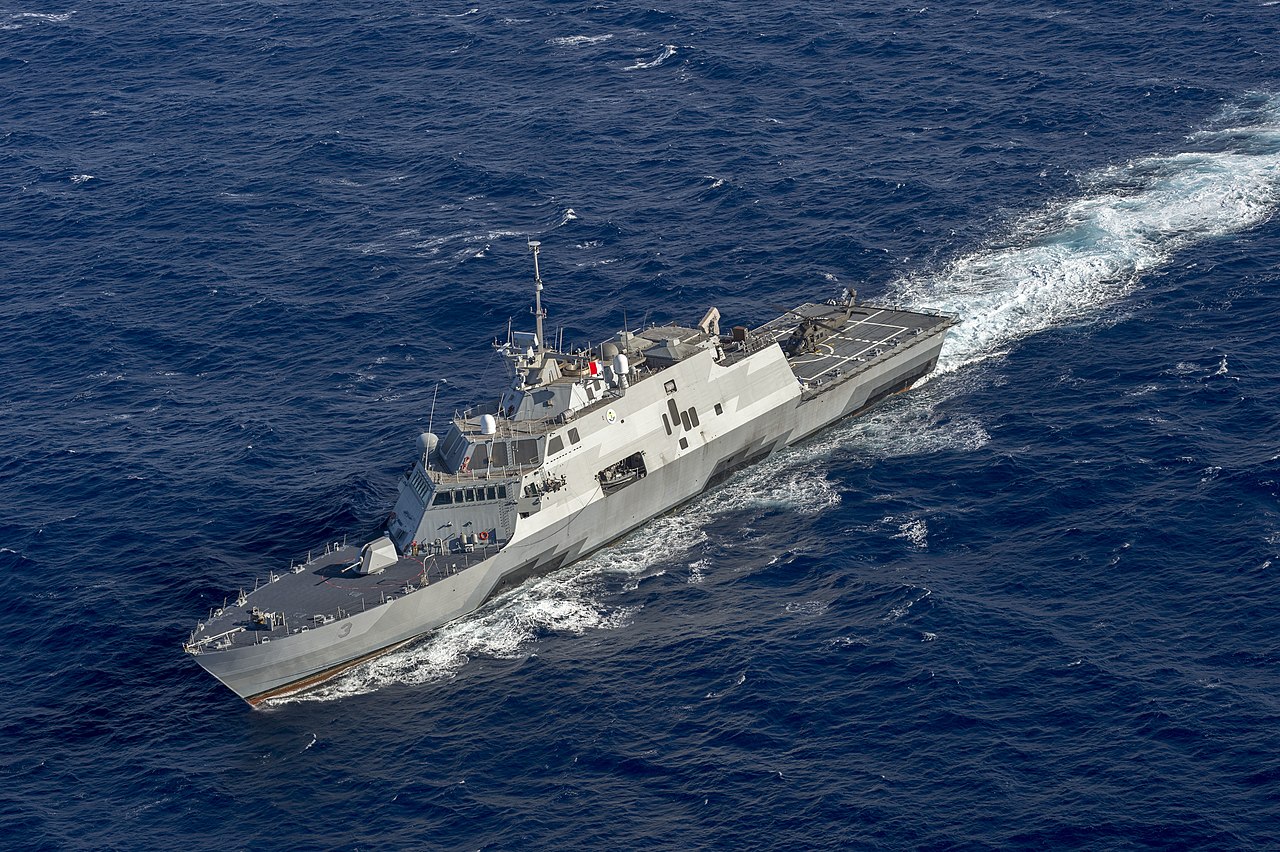
Fort Worth of the Freedom class
To achieve this speed, along with reasonable economy, both ships use a combination of diesels and gas turbines driving a quartet of waterjets instead of conventional propellers, although the actual hardware used is different between the two classes. Range at high speed is rather limited, with Freedom able to make about 1,100 nm at 45 kts, while Independence can make about 1,800 nm. At a cruising speed of 18 kts, this increases to 3,500 nm and 4,600 nm respectively. Built-in armament for both versions is pretty light. A 57mm Bofors gun is capable of firing 220 rounds per minute out to 9 nm. While primarily intended for use against small boats it has some capability against land and air targets, and it is backed up by a few machine guns for close-in defense. Air defense is the primary responsibility of RIM-116 Rolling Airframe Missiles. Freedom carries a 21-round box launcher, while Independence makes use of SeaRAM, an 11-round RAM launcher fitted to the radar system of the Phalanx CIWS. While RAM is a capable missile, neither ship is capable of operating independently in high-threat environments.
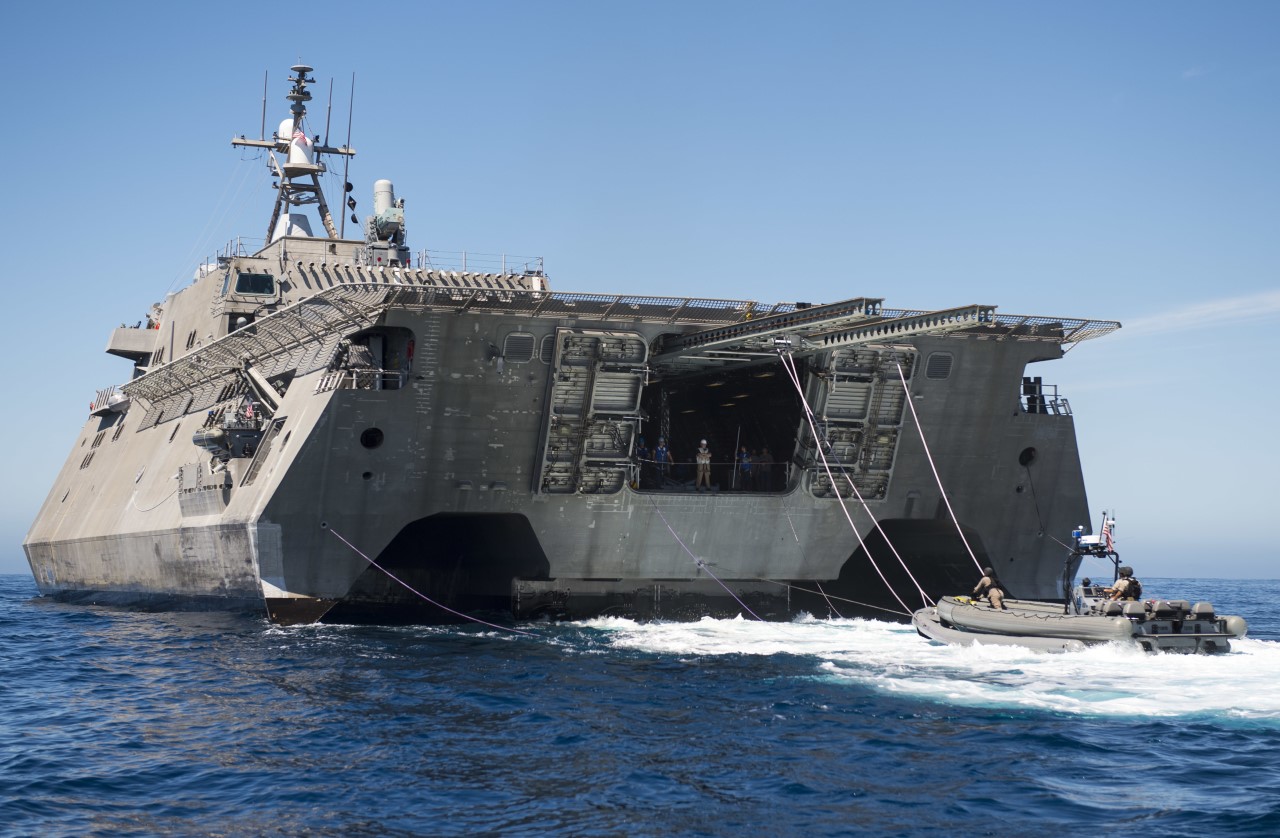
A boat is recovered using the stern doors and crane on Independence
But the LCS was never intended to fight primarily with its built-in weapons, and as such, both ships were designed around carrying and supporting modular payloads. This means not only reserving space and weight for onboard systems, but also having the capability to deploy manned and unmanned craft into the air, onto the surface, or below the waves. Both ships are fitted with stern doors and cranes which allow launch and recovery of craft up to Sea State 4 (8' waves), be they manned boats for boarding parties, remotely-operated submarines for minesweeping, or towed sonars for ASW. Reports indicate that the Freedom class has the advantage in boat handling, but it is eclipsed by the superior flight deck of the Independence, the largest fitted to any American surface combatant, and capable of comfortably handling any helicopter in the US inventory. Both ships are designed to operate a pair of MH-60 helicopters, although a more typical loadout is one MH-60 and either a single MQ-8C Fire Scout UAV or two smaller MQ-8Bs.3 The extensive mission volume (11,000 m3 for Independence, another benefit of the trimaran hull) also gives the ships a secondary role as high-speed transports, and Independence is fitted with a ramp to allow vehicles to be driven on and off while at the pier.
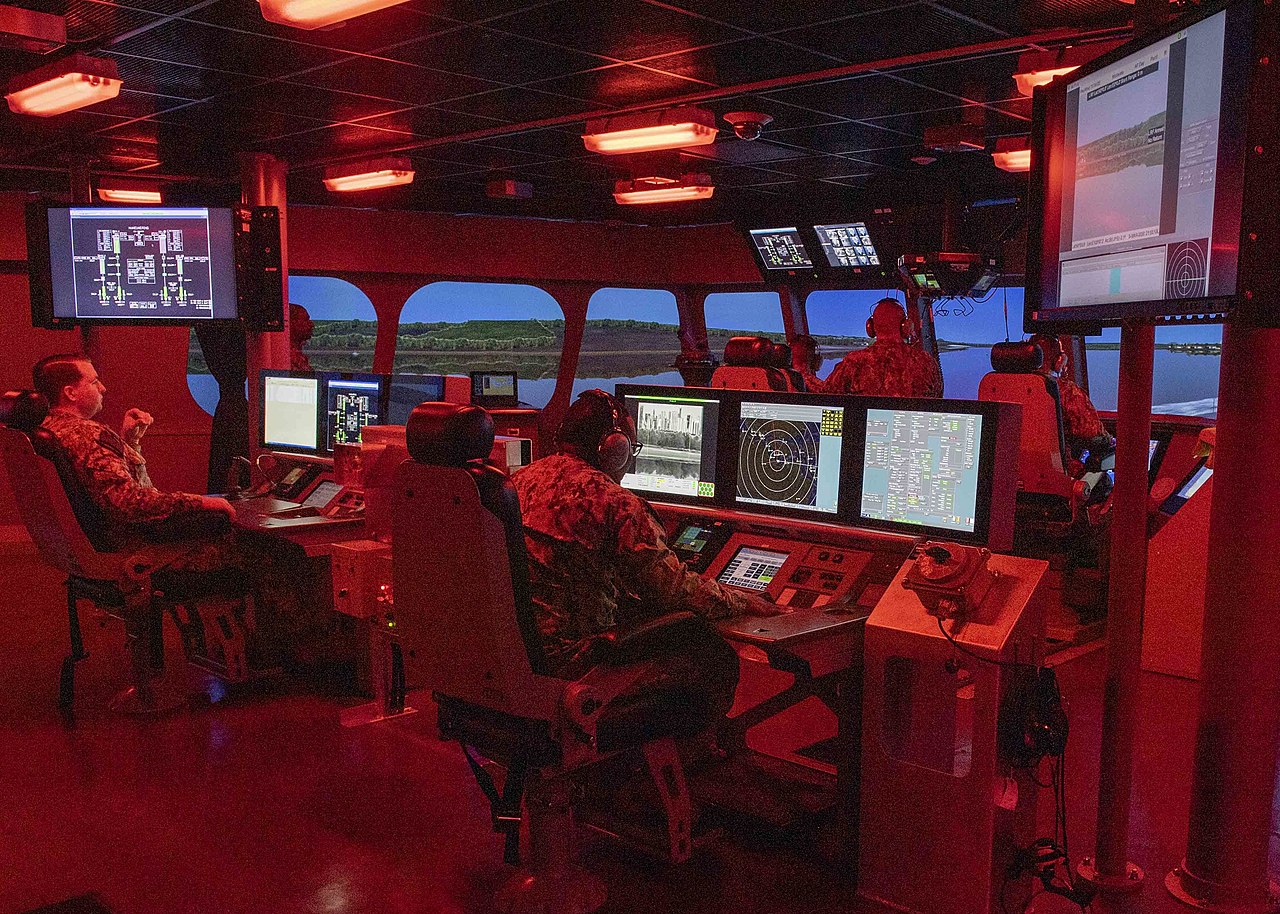
An LCS crew uses an Integrated Tactical Trainer ashore
One other innovation was minimal manning, an attempt to reduce what is a major cost of owning and operating warships. While conventional ships of this size usually have crews of 100-180, the LCS program started with discussions of as few as 15 sailors in the "core crew", to be supplemented by extra "mission crew" to operate the mission modules. This number was too unbelievable even for the program at the time, and the ships as finally built were intended to have a core crew of 40, backed up by 35 more to operate embarked systems, including mission modules and aircraft. This would be enabled by moving many logistics and training functions ashore, as well as cross-training the existing crew in multiple duties.4 Availability would be enhanced by having multiple crews for each ship. The initial plan was to operate 3-2-1, with three crews, 2 hulls, and 1 deployed, although the current plan is to have 4-ship squadrons with a dedicated training ship based in the US and each of the other 3 ships assigned "blue" and "gold" crews, on the model used by missile submarines. In practice, the 40-man crews have generally been overloaded, and there has been much discussion of increasing manning, although with unclear results.
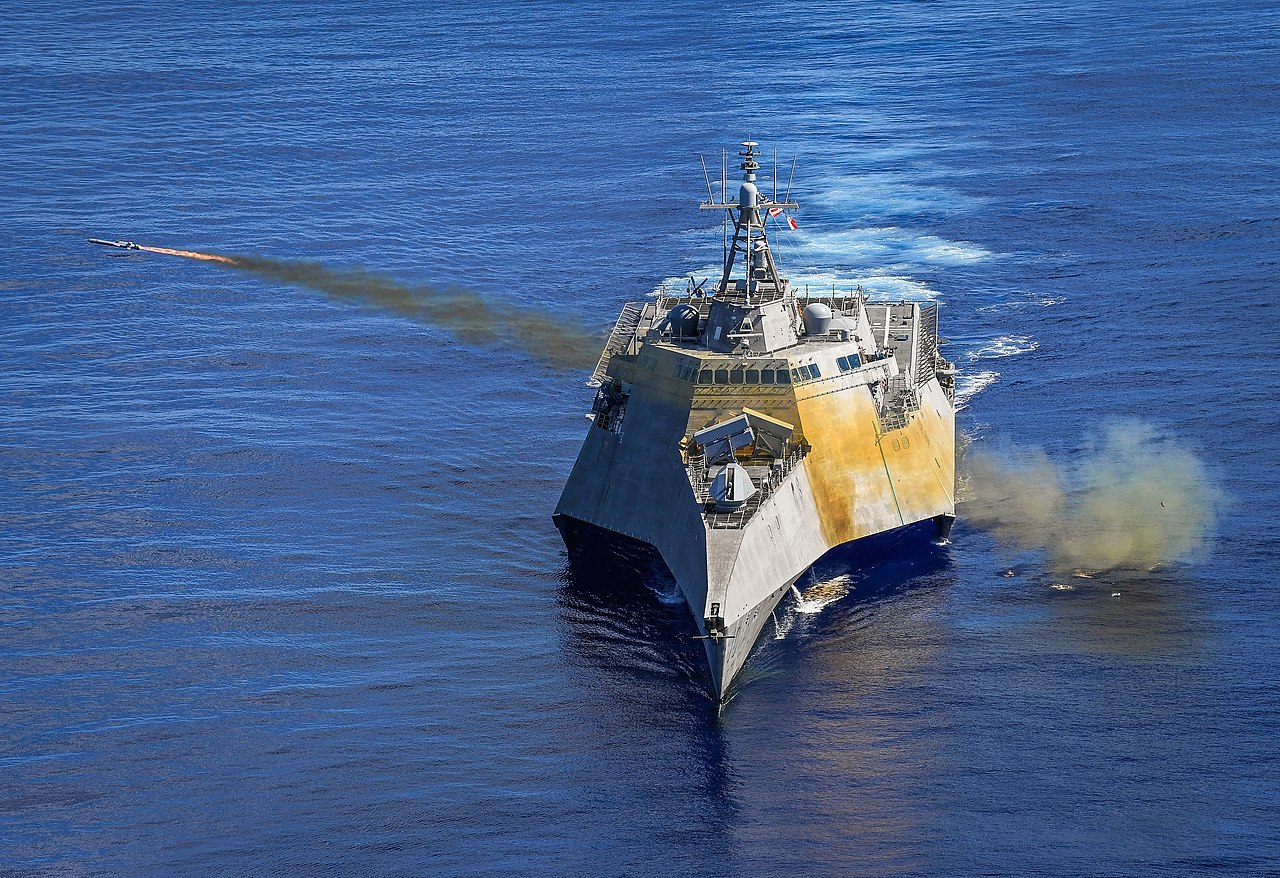
USS Gabrielle Giffords5 fires a Naval Strike Missile
But what about the modules themselves? The original plan was to build three types of modules to cover the missions that analysis showed were needed in the littorals: mine countermeasures (MCM), anti-submarine warfare (ASW) and surface warfare (SUW). Ships would be able to run to a friendly port and change out in a few hours, giving unmatched capabilities. Unfortunately, as bad as the ship procurement program was, the situation with the modules was far worse, going zero for three on delivering successful systems. The surface-warfare module was originally intended to be a pair of 30mm chain guns for close-in defense against swarming boats, and 15 vertically-launched Non-Line of Sight missiles for longer-range firepower. Unfortunately, the NLOS missile was cancelled in 2010 thanks to cost and schedule problems, leaving the Navy scrambling for a replacement. The first proposal was to use the Griffin, which would triple the number of missiles carried, but reduce the range from 40 km to 5 km. Nobody was happy with this, as it would give the missile less range than the gun (although guidance would make up for this to some extent), so the Longbow Hellfire was substituted, with 24 missiles capable of reaching out to 8 km or so.6 At the time, this was seen as necessary to deal with the small boat swarms the LCS was targeted against, but since then, attention has shifted towards dealing with bigger threats. Tests have been run with Harpoon, and current discussion is centered around fitting the Norwegian Naval Strike Missile to give punch out to 100 nm or so, although the ships appear to be limited to only 8 of either missile. At the moment, the best anti-ship system available remains the MH-60 fitted with Hellfires.
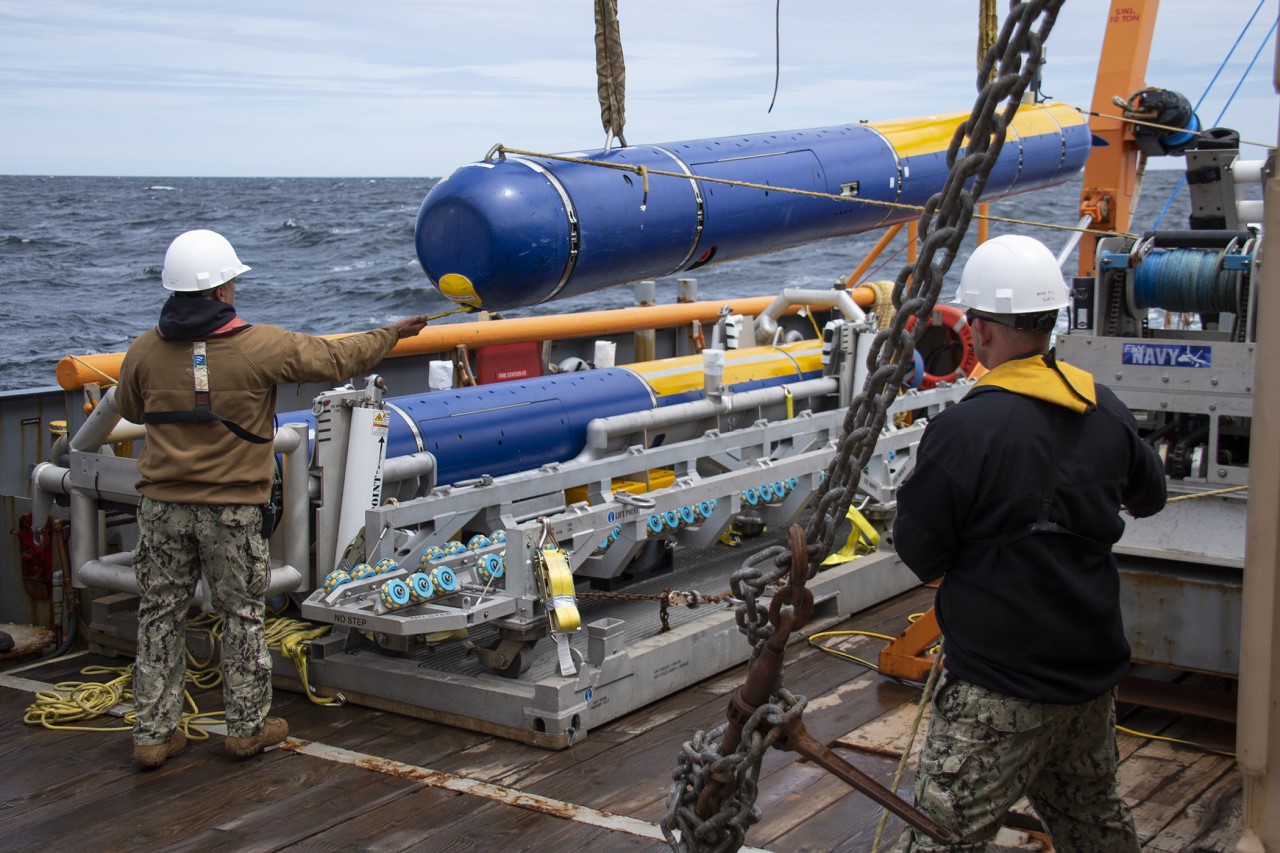
A Knifefish minehunting UUV
The situation for the MCM and ASW modules is even worse. The former was built around the WLD-1, a semi-submersible unmanned vehicle towing a mine detection sonar, an unmanned surface vehicle (USV) for minesweeping and an airborne system fitted to the MH-60S for minehunting from above. Unfortunately, the WLD-1 proved horribly unreliable and had to be scrapped and replaced with the Knifefish UUV, while the other systems are just now completing development, a decade after they should have entered service. The ASW package was such a mess that the first attempt was entirely cancelled in 2008, and development of its replacement was dogged by a lack of clarity over missions. The original package was intended to be operated almost exclusively against diesel submarines in shallow water, but the focus shifted to giving some capability while in deeper water later on. Also an issue was the need to operate systems while the LCS is underway, instead of requiring it to be stationary. By early 2021, the package was planned to be a passive towed array, a separate sound source to allow active operations, and a torpedo decoy, with the job of actually killing the target falling to the onboard MH-60R, but by early 2022, the problems had reached the point that the Navy decided to pull the plug and give the ASW mission to the new Constellation class.
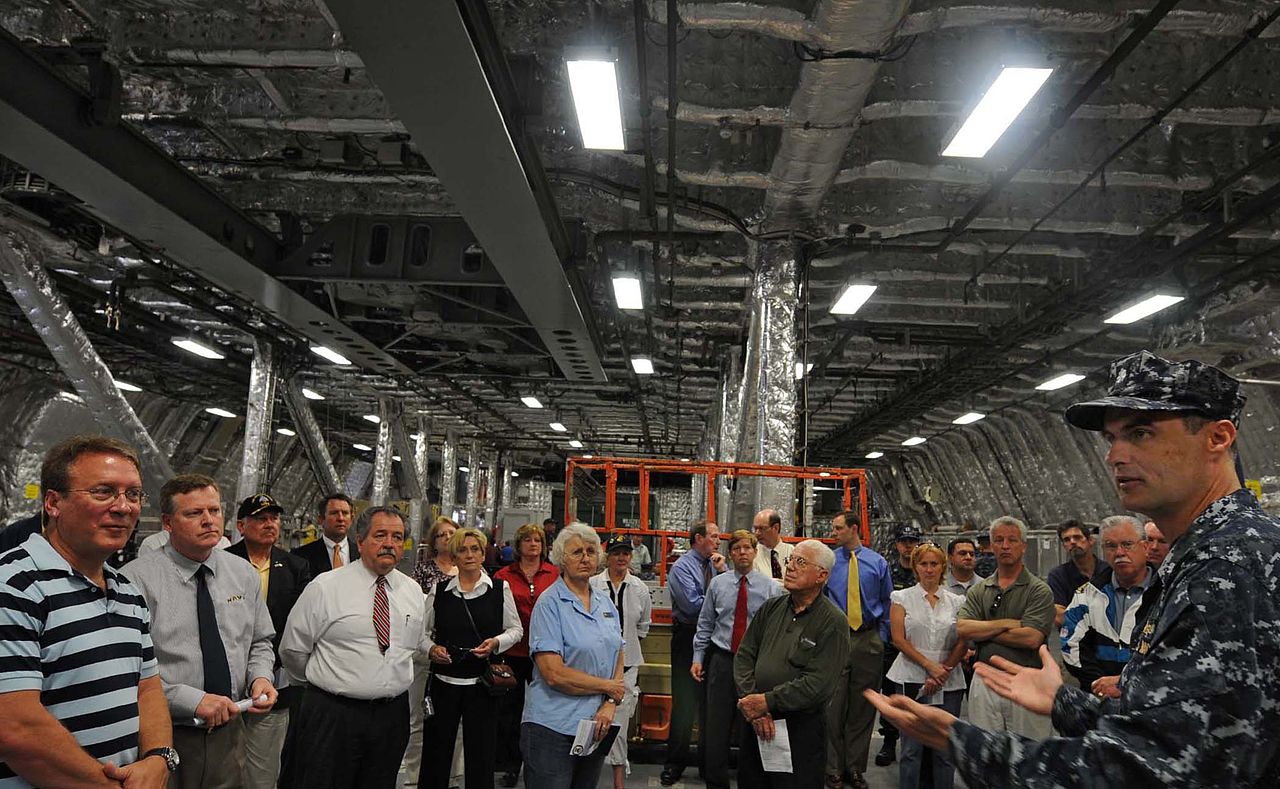
Visitors tour the mission bay aboard Independence
Capping off the failure of the mission modules was a decision in 2016 to retreat from the quick-change plans in favor of dedicating each ship to a specific mission. Each coast would have three divisions of four ships each, and each division would specialize in a specific mission. Two major factors seem to have driven this decision. First, it was a lot harder to swap modules around than the original designers assumed, and budget limitations meant it wasn't really practical to have a bunch of extra modules laying around to give that flexibility. Second, the core crew couldn't easily swap missions at the drop of a hat. They needed practice integrating the modules and their crews to actually be effective. The result is something more like the original StanFlex system that inspired the modular design in the first place. StanFlex was originally designed by the Danish Navy to allow a single class of new ships to take over a number of roles, including minehunting, coastal surveillance/pollution control, surveying, minelaying, and even missile attack. Each system was packaged into a standard container, which was fitted to a slot on the ship's deck. While this in theory allowed ships to rapidly reconfigure between missions, in practice, they tended to be dedicated to a single mission for a long period of time. The benefits of the system were found in allowing a single hull design to easily carry multiple mission systems, and in making it far easier to upgrade said systems because the work could be done ashore instead of onboard the ship. Today, systems installed in StanFlex containers range from ESSM and Harpoon missiles to surveying equipment and cranes, and the Danes have it on almost all of their warships. The USN occasionally makes noises about procuring more types of LCS mission module, most regularly a module for special forces support, with extra berthing and support for their boats and helicopters, but the move to the division structure throws doubt on such plans. In 2021, plans were announced to fit most of the ships with missiles, with half of the ships getting MCM modules and half ASW modules. It appears that the MCM systems would go on the Independence class ships, while the Freedoms got the ASW modules. NSM is the most likely missile, although this isn't entirely clear.
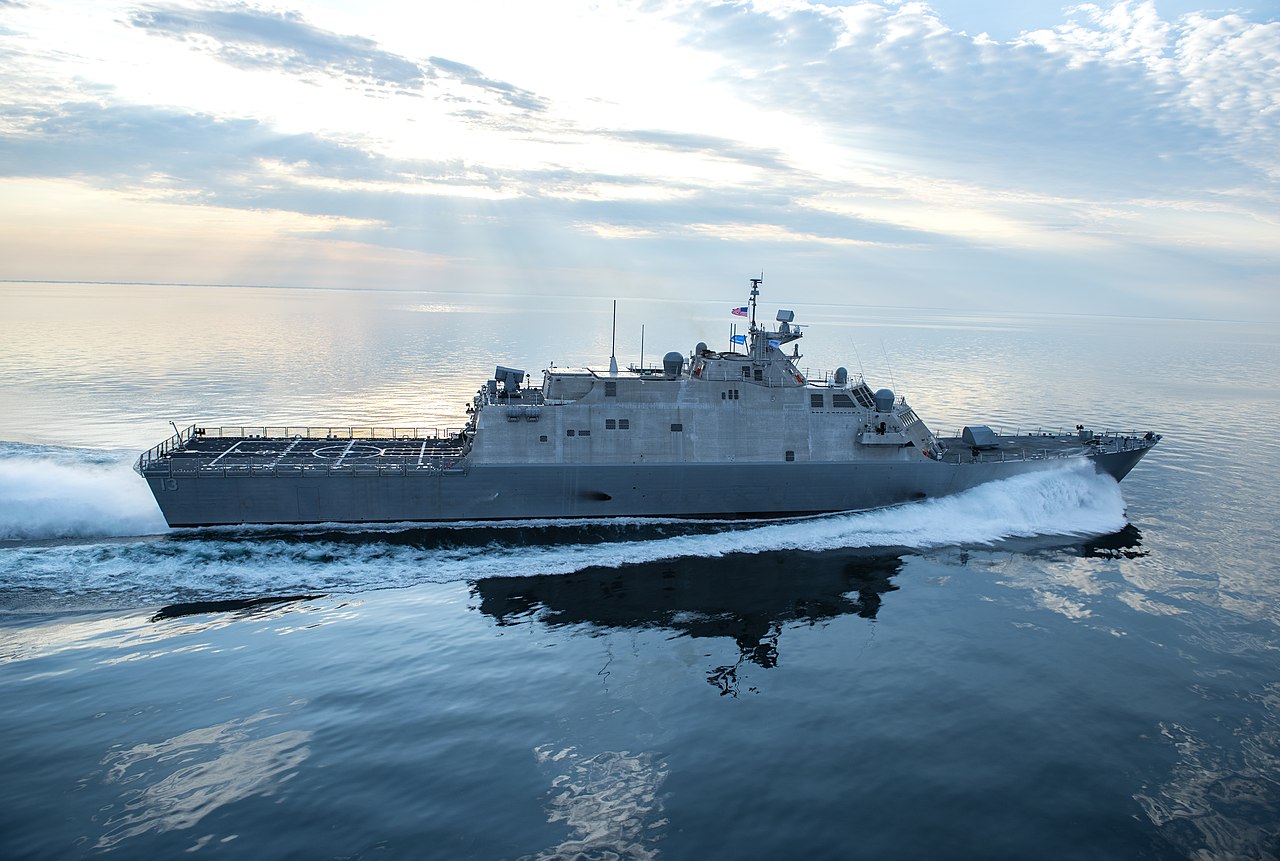
USS Wichita runs trials on Lake Michigan
But before we can render a final verdict on the LCS, we need to take a look at how these ships have performed in service. That will be our topic for next time.
1 This ship was originally designed by General Dynamics and Bath Iron Works, but the program was transferred to Austal at some point before 2010 for complicated political reasons. ⇑
2 Only a tiny handful of large warships have ever made anything like that speed, most notably the French Le Fantasque class destroyers. But that was only on trials, and in service, they were far slower. Modern design standards are stricter, and the LCS should be able to make 45 kts in service, at least if the seas are calm. ⇑
3 Or at least it was before both types were retired, the MQ-8B in 2022 and the MQ-8C in 2024. I'm not sure exactly why that happened, or what the future of the naval unmanned helicopter is. ⇑
4 This was probably one of the motivations for the disastrous attempt to remove the Navy's rating system in 2016. It was a complete failure, and SecNav Mabus was forced to retreat by outrage from all quarters. ⇑
5 This is by far and away my least favorite ship name ever. I have nothing against Ms. Giffords personally, but she has never served in uniform, and was not involved in military affairs while in Congress. To put it crudely, there are lots of other people who got shot while in the military who deserve ships far more (at least in part because they didn't survive) and Ray Mabus should be ashamed of himself for such naked political pandering. ⇑
6 This is less than the air-launched version, but surface-launched weapons always lose range from having to start at sea level. ⇑

Comments
The only other warship (barring patrol craft and the like) I've heard of with a similarly-sized complement is the unusual Soviet Alfa-class, which had 31 crew (up from the originally proposed 14 crewmen.)
I'm a bit confused – pictures that I've seen, including the one in this article, indicate that the LCS carries 2 quad NSM box launchers for a total of 8 missiles.
(Incidentally, what do you think about the NSM? I've always felt like American anti-ship missiles are too slow – would a low signature really close the deal against a major surface combatant or would it be relegated to sniping corvettes and obsolete ships?)
Interesting parallel with the Alfa. Hadn't thought of that, but it holds up. Other areas of similarity are the speed and the catastrophic engineering problems.
As for the NSMs, you're correct. I misidentified those as twins, not quads, but a photo from a different angle was pretty clear.
I'm reasonably positive on the NSM, and the slow, stealthy missile in general. Faster missiles have a bigger signature and are easier to detect, and tend strongly to be heavier and more expensive.
Also, it looks like they're planning to fit NSMs to all of the LCSs (minus the ones to be retired) and double that up with either the MCM or ASW mission module. Gilday announced this in Congressional testimony last week, and I found it while looking for the NSM numbers.
Realized that the mission packages give you another advantage. When all your minesweepers get holes in them, you can probably get the gear back in service faster by swapping it to an undamaged ship.
That said, with modern mines and torps capable of snapping ships in half, maybe surviving battle damage isn't something you can count on...
By dedicated training ship, do you mean one vessel that never deploys?
Overall you make the program sound like a total boondoggle that was halfway salvaged, and still has chances to prove itself if events ever force the navy to start acting sensibly.
You’d basically have to transfer the equipment anyway, given the questionable survivability of the LCS. (Coming next time...)
I think so. There’s a lot of integration that goes into running a ship, and the best training comes full-scale. Normally, this is done on the operational vessel, but doing it on a surrogate makes sense if you’re rotating like they are here. That said, I wouldn’t be surprised if the “training vessel” actually spends most of its time in the yard, and is swapped out every 6 months to a year when the next ship is due for a big overhaul.
That's an accurate summary of my view on the program.
So far your thinking on the Little Crappy Ship seems to mostly track mine - an incoherent answer to a question that nobody quite understood, but maybe someone can make something useful out of it after all. (Polishing a turd, I think, but at least at the end of it, the turd will be polished!)
I think it also had one other annoying consequence - getting the bizarre 57mm Mk 110 gun thoroughly integrated into the USN's logistics chain. I think the Mk 110 is an interesting option for small ships that mostly need a CIWS that can do double-duty as a deck gun in a pinch, but that everywhere the US is using it, the OTO Melara 76mm SR with DART would be a better fit (especially on the Legend-class cutters and new frigates). Am I off the mark on that one? Is there some reason why the 57mm really is a better fit?
Shouldn't there be a 'Ship' in the post title?
@Jade
My understanding is that the USN fell victim to sales puffery on the part of Bofors and whoever was making fancy ammo for the 57mm, which they claimed would make it equivalent to a 76mm. In retrospect, the 76mm SR would be a better option, but once you’ve actually done the work of getting the 57mm into the system, then replacing it gets expensive. My first guess was weight, but Navweaps suggests that the two weigh about the same.
@ike
Oops. Fixed.
Was part of a discussion about space warship design some years ago, and the LCS came up. According to one of the participants, the two types of LCS cannot use each other's modules. After the original contracts had been tendered and accepted, the USN apparently changed the specs for the modules and demanded that the ships be altered at no extra cost. One contractor agreed, the other said no.
Bean or anyone, confirm or dispel?
Didn't run across any claims to that effect in my research, or even any hints that it might be the case in terms of major equipment items being different. I could believe that there are some minor things which keep you from being able to just grab a module out of one type of ship and slot it into another (cables are the wrong length or something of that nature) but I suspect that those are pretty minor.
What's going on here? Is it that a monohull only has one wake while the trimaran has three all interacting?
footnote 1
The ship was based on an Austal ferry design and Austal had actual experience building multihulls so they were almost certainly involved in much of the design even if the original intention had been for them to be consultants.
Hugh:
Given the different hull forms I'd be surprised if they could.
It sounds like a vertical launch version of the SPEAR 3 missile would be about right. Then again, you could probably develop a helicopter launched version, at which point the MH60 becomes the best option again.
No idea.
Austal was involved throughout the design process, although the team was led by GD/BIW during the development phase. I included the footnote to explain why I went from talking about GD/BWI to talking about Austal.
Depends on what you're trying to do. For the anti-swarm mission, that wouldn't be a bad choice, although it's worth pointing out that SPEAR 3 is a Brimstone derivative, which in turn came out of Hellfire. I'd probably take NSM for the heavy anti-ship role.
Can we just use the RIM-116 in its surface-target mode for the anti-swarm role? It should have about the same performance as Brimstone, though not the range of SPEAR-3. More expensive than either, but that would probably come down a bit in high-volume production. And for a small multi-mission ship, the worst sort of expense is all the money you spent on weapons optimized for a single narrow target set that the enemy doesn't present you with.
The Surface Warfare mission module can mostly be a speedloader for the existing RAM or SeaRAM launchers :-). Also we should be honest and call it the "killing lots of small boats but absolutely nothing else" module, because if you call it a "Surface Warfare" mission module people might think it has at least some capability against an old 1980s fast-attack craft or a WW2 surplus destroyer.
@bean I think that the extra range of Spear over Hellfire would make a significant difference, though NSM is good too. I think (potentially) being able to fit into a VLS like ESSM would be a strong point in favour of the smaller missile.
@John How much of an improvement over the 57mm is RAM when it comes to surface targets? I wouldn't be surprised if a 3" Oto Melara with DART could cover both roles.
I think SPEAR 3 would need a booster for surface launch, which would be a significant cost, but it could make sense. Not sure about VLS NSM. Haven't heard of them trying that, but no reason they couldn't fit it with a booster to do so.
As for RAM for small-boat killing, I think it had to do with the original plan for NLOS, which would have had much greater range. Also, you might want RAM for shooting missiles. It's pretty much moot, though, as all of them seem to be getting SSMs over the next few years.
I'm sure it would, but you could probably use the booster from e.g. Sea Ceptor, though as you say, not without cost. I haven't heard of a vertical launch version of NSM, but even if one was developed, it certainly couldn't be quad packed. Regarding RAM, I think even if it is necessary for shooting missiles (and if they'd opted for 76mm with DART, it wouldn't be) it may not be much better than gunfire for surface warfare.
Is there any evidence that DART is at all useful, that isn't A: the manufacturer's advertising and B: five or more years old? As Bean notes, part of the reason we're in this mess is that the USN seems to have been taken in by the manufacturer's advertising for the 57mm gun.
Compared to which, the RIM-116 has about an order of magnitude larger bursting charge in the warhead (and one optimized for one-shot kills of targets in the 10-50 ton range), and an effective range against small maneuvering targets of at least 10 km vs maybe 2km for the 57mm gun.
The one thing it doesn't have, which most of the other proposed systems don't have either, is range out to the radar horizon. You'd want that if you're going up against a classic fast attack craft with real antiship missiles. That's where SPEAR-3 might do well. The NSM would obviously be up for that, but it's heavy expensive overkill in that application. ESSM would also probably be a good fit there, while also having a useful air/missile defense role. Neither of the LCS models carry it, but most everything that has been proposed as an LCS alternative (including the FFG-X) do.
Dual-purpose guns always beat shipping separate batteries of antisurface and antiaircraft weapons, except when you needed particularly heavy antisurface weapons for shore bombardment or sinking large warships. I think the same will prove true of missiles.
No evidence that I have, and perhaps it doesn't perform as expected. I think my impression of its performance was from bean trying it out in Command: modern air/naval operations on one of the teams meet ups, so not exactly rigourous analysis Ü
One of the advantages of systems that are in more widespread service (like RAM and ESSM) is that they get more testing, operational experience and development. If ESSM performs as well against surface targets as Spear would, and also provides excellent air defence (and it already exists) perhaps VLSpear wouldn't offer much.
We already know that old-style Sea Sparrow can mission-kill a WWII destroyer from better than 5 kilometers; the evolved version is faster, with a better warhead and better guidance.
https://en.wikipedia.org/wiki/TCGMuavenet(DM_357)
Could an argument be made for VL Spear based on a greater effectiveness against land targets? It sounds like ESSM is the better choice generally, especially because it is already developed, in service, and has even been used in combat. Having said that, a ship that is operating in the littorals may have more use for land attack than typical surface combatants. Then again, I expect that if you are after a dual purpose land attack/anti ship missile then something larger like NSM or LRASM would be a more obvious choice, in part because of the greater range, and also because they'd be a better complement to ESSM thanks to their larger warhead. I am still kind of keeping my fingers crossed for a surface launch option for Spear, because i think it would be a good alternative to Ground Launched SDB, and a potential successor to Spike NLOS/Exactor for the British Army, and that would be much more likely to happen if the US decided to take an interest.
Land targets would be a good argument for something like the Spear, presuming the ship-launched version can be set up for that. The question there would be how you arrange the datalink; using the helicopter as a relay would be one good answer but if you can count on the helicopter you can just use it directly.
But a littoral combat ship is going to be operating close to enemy shores, so it's going to need to be able to project power ashore - if only because the shore is likely to project power back out to sea with e.g. mobile missile batteries, and you want to be able to do something proactive about that.
A medium-caliber gun with guided ammunition would be another good approach, but 57mm is certainly not up for that job. The helicopter, if it's available. If you're shipping heavy antisurface missiles like NSM or Harpoon, a guidance option for engaging land targets is strongly preferred. But not everything needs a 500-lb warhead, and something smaller and more flexible would be very nice.
You can spot with something as light as a Blackjack (the UAV, not the supersonic heavy bomber), though I don't know if it could guide in a missile. I imagine a similar small UAV could do the job, which would give you options when the helicopter was unavailable or otherwise engaged.
Regarding NSM, might it not be better to integrate it with the Seahawk? Use ESSM for defence against closer targets, and the helicopter for anything over the horizon?
The helicopter is the most capable and most important weapons system on any multirole frigate or frigateoid, but helicopters have maybe 50% availability even in calm seas and clear skies. Crews need sleep, breakdowns happen, and even routine maintenance takes time. So for anything critical, you really don't want the answer to begin and end with "that's what the helicopter is for".
But because the land doesn't move and the ship can, it may be reasonable to say "land target engagement isn't that critical; if need be we can pull back over the horizon and wait until the helicopter is back on line to engage that missile battery".
I think I'm now satisfied that larger anti-ship missiles and land attack missiles could be put in that 'non-critical' category, at least for a less capable cheap frigate/LCS that also has ESSM, but I'm now thinking about ASROC. If the worst happens, and you don't detect a sub until it puts a torpedo in the water, being able to shoot back looks pretty 'critical'. Would it be reasonable to say that a frigate operating in the coastal areas where diesel electric submarines are most effective, should keep a handful of ASROC on hand as backup for the helicopter?
Re waterjet propulsion: DK Brown in Rebuilding the Royal Navy mentions being involved in a high speed frigate study (40 knots cruise, 43 max) in the early 60s. Apparently they calculated that with the metallurgy of the day, the best available propeller would have had service life of around 20 hours.
I suspect we could do a lot better than that today, thanks to better design to suppress cavitation, but that's definitely an amusing statistic. Also a reminder that I need to re-read those books.
Ain't no shame in Ray Ray's game
On the subject of using RAM for small-boat defense, it absolutely can be done, but given the limited magazines for them, it can't maintain the volume of fire, or be reloaded fast enough.